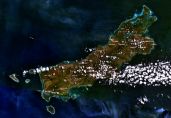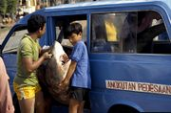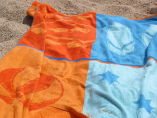introduction

Boffin: Timor; 20 June 2004
Timor is one of the numerous islands in Indonesia, located at the south end of the Malay Archipelago, north of the Timor Sea. The whole island is devided in two parts: the independent state of East Timor, and West Timor, belonging to the Indonesian province of East Nusa Tenggara. The total area of the island is 30,780 km².
surfing

NASA: Roti Island, Timor, Indonesia; 2005
Once Timor was one island, today the fledgling and strife torn nation of East Timor (Timor Leste) lies at the eastern end of the island with Timor, the remnant of the former Portuguese colony still remaining as a province of Indonesia.
The swell has to bend ever so far from the South West to reach Timor which limits surfing to all but the largest swell systems. Still, anything that reaches this far east has travelled an extreme distance and will often be of a superior period. The offshore island of Roti is a veritable swell magnet and holds the majority of discovered spots. There is a lot left out there but this decade isn't looking good for one to be venturing along the Timor coast in search of waves.
This is another area that is going to be saved by surfing one day...mark those words.
travel

Spolloman: Bemo; 18 May 2005
There are many ways of getting around Indo: by plane, bus, car, boat, train, ojek or becak. The last one, pronounced as "BEH-chuck", is a tricycle (pedicab) transportation mode for short distances such as residential areas in many cities. The better your communication skills are, the less you will pay and check the cost beforehand. By the way, there are no becak in Jakarta. Instead, there is the motorized bajaj (BAH-jai). In some other provinces (eg. North Sumatra, Aceh) there are motorbikes with sidecars, known as bentor (short for becak bermotor).
Ojek is motorcycle taxi, which you may want to take if you're in such a hurry that you're willing to lose a limb to get there.
Car is not the safest way to travel as well – rules on the roads are ignored, driving on the road shoulder is common, buses speed like maniacs and stop without warning, pedestrians cross the road anywhere, even across highways…and police is not doing anything about this mess. So it’s your decision, mates. Just in case you still decide to hire a car, the traffic moves on the left in Indonesia.
Not sure if you should consider bus as well…drivers are often drunk, on drugs or just reckless; keep an eye on your bags at all times and avoid overnight journeys in the wilder parts of the country (notably South Sumatra).
Travelling by plane is probably the safest option, though the safety record of the smaller companies is dubious. But the good thing is that a select a few carriers, such as Garuda, Lion Air, and Mandala among others, have recently bought brand new planes straight from an aircraft manufacturer which have replaced some of the older planes in their fleet. So the situation is a bit better, though be prepared that many carriers have poor on-time records and frequent cancellations.
Ferries are very popular and with PELNI (the largest company) you can go to practically every inhabited island in Indonesia. But as usual, safety records are poor, so look for safety devices on board and postpone your trip if the weather is bad.
Java by far has the best railway network; some parts of Sumatra are covered as well. Journey will take quite a long time, but the scenery is a bonus. Be aware of theft and lock your doors at night.
where to stay

Jpatokal: Puri Mas, Lombok, Indonesia, 5 December 2005
Dili is the only place to find accommodation in Timor. There are plenty of hotels there, ranging from budget (No facilities but dirt cheap) to fairly moderate (Air conditioning and cable TV).
Some cafes around town have ads for accommodation posted up, but generally the best way to find out accommodation is to ask around. Most people are more than happy to help!
Common accommodation options include ‘Kos’ style accommodation, where you rent a room with an East Timorese family and though no cooking facilities are available, you can usually share meals with them. Rent is generally about $160 per month.
Another option is to share accommodation with other foreigners – there are plenty of shared houses. Few houses have washing machines and most would not have an air conditioning or any furniture at all – which may involve a significant initial cost. Shared houses are usually about $150 and $200 per month.
Alternatively, these are some hotels you might want to take a look at:
• Central Hotel
• Venture Hotel
what to pack

Xavigivax: Beach towel; 13 November 2007
Bring your own toilet paper and anti-septic hand-shower stuff. Trainers, loose clothing - everything for the hot weather.
A small backpack makes a good carryon bag and will be useful in daily life. Wear comfortable shoes and expect to do alot of walking! Bring a hat and sunscreen to protect yourself from the sun!
Bring plenty of memory for digital cameras and bring plenty of batteries. And take a good protection for your camera from the sand.






